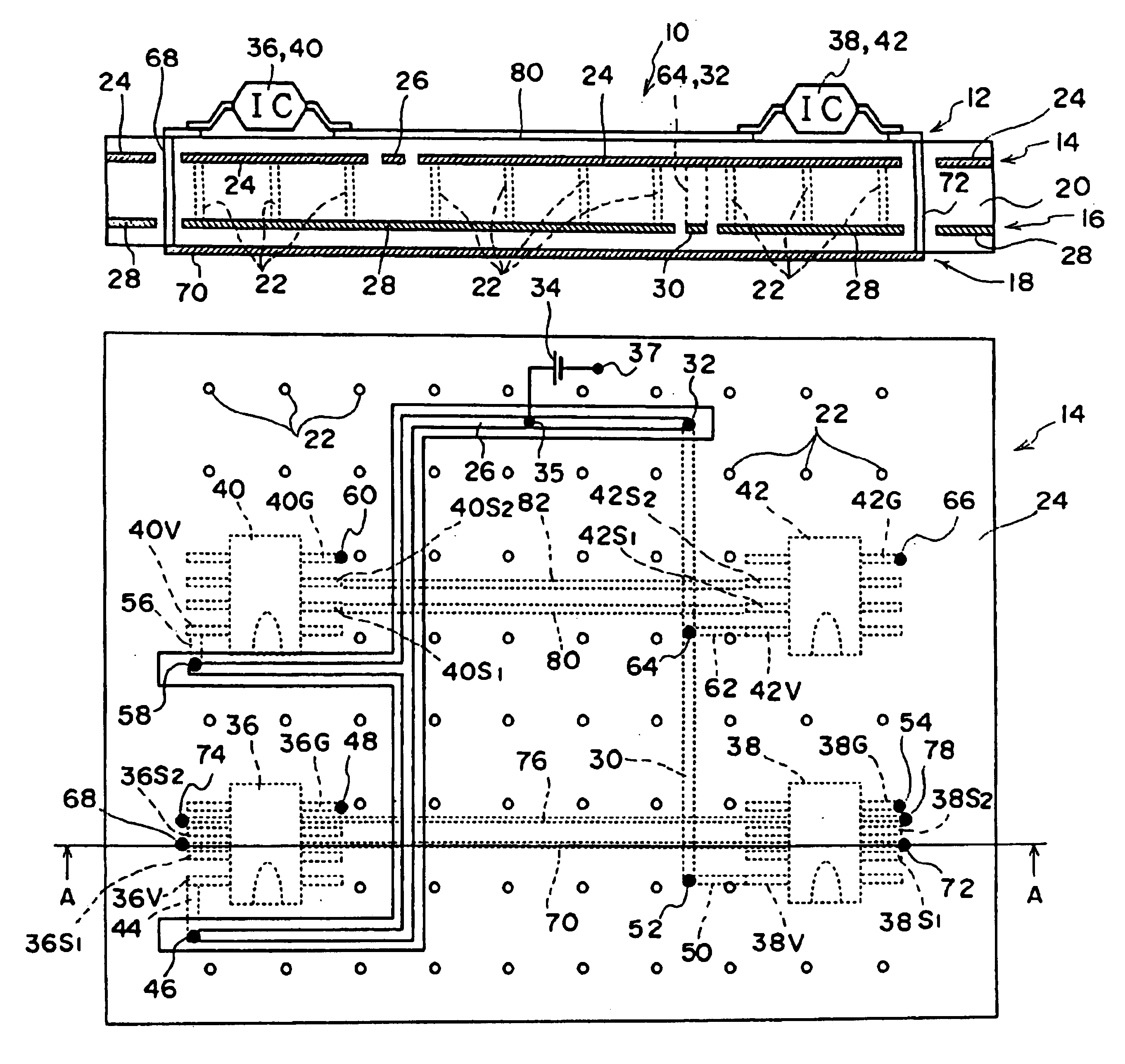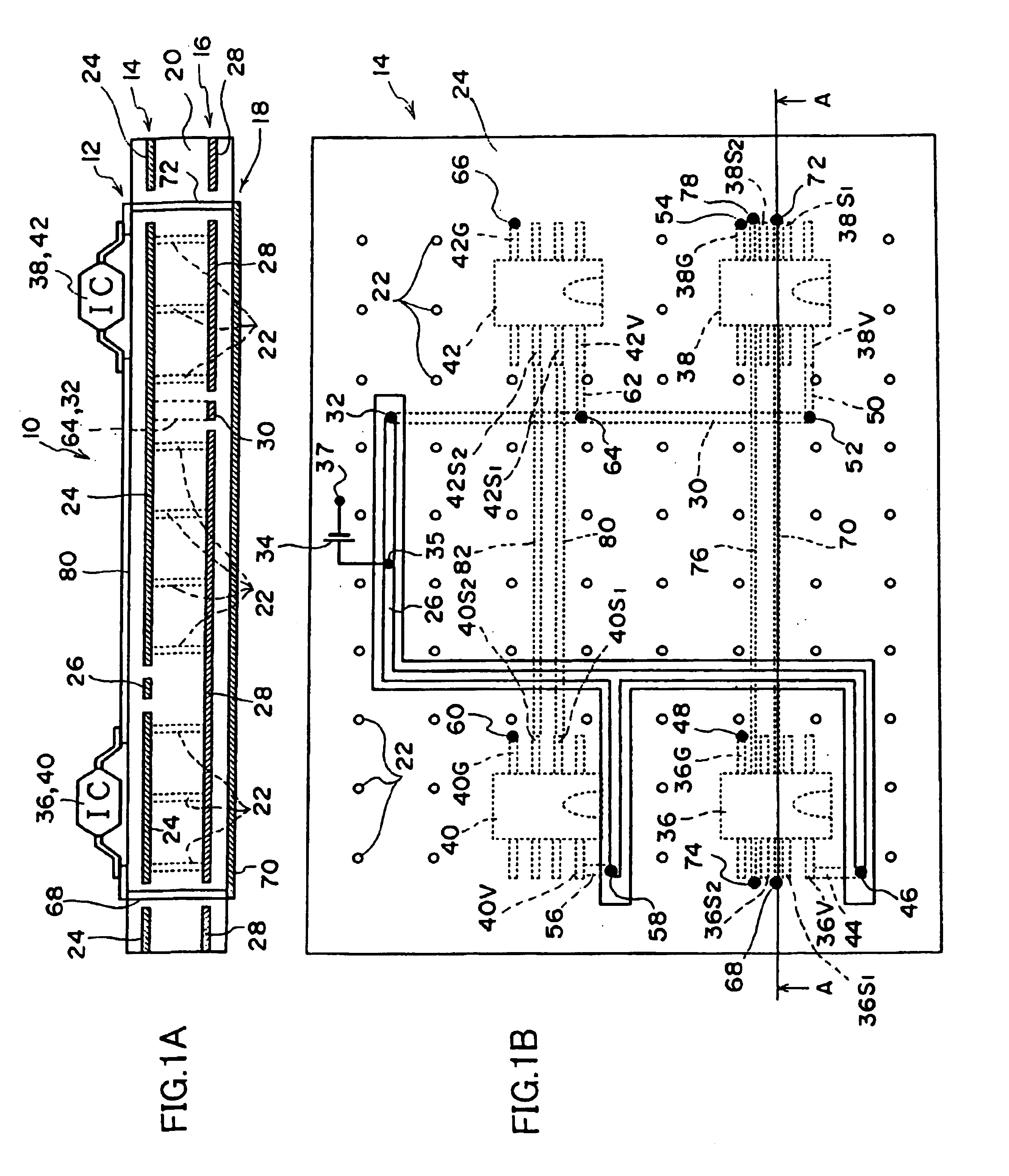Printed wiring board
a wiring board and printed technology, applied in the direction of electrical apparatus construction details, electrical apparatus casings/cabinets/drawers, cross-talk/noise/interference reduction, etc., can solve the problem of not being able to completely eliminate the resonance current, aforementioned effect not being achieved with respect to the resonance current of high frequency, etc. problem, to achieve the effect of suppressing the radiation of electromagnetic waves and preventing the reduction of the density of mounting
- Summary
- Abstract
- Description
- Claims
- Application Information
AI Technical Summary
Benefits of technology
Problems solved by technology
Method used
Image
Examples
first embodiment
[First Embodiment]
[0092]A first embodiment of the present invention will be described hereinafter.
[0093]FIG. 1A is a schematic sectional view of a printed wiring board 10 relating to the present embodiment. As shown in FIG. 1A, the printed wiring board 10 is a four-layer board having a multilayer structure in which a first signal wire layer 12, a first ground layer 14, a second ground layer 16, and a second signal wire layer 18 are laminated via an insulating material 20.
[0094]FIG. 1B is a plan view of the first ground layer 14. Note that FIG. 1A is a sectional view, taken along line A—A, of FIG. 1B.
[0095]As shown in FIGS. 1A and 1B, the first ground layer 14 and the second ground layer 16 are interlayer-connected by a large number of via holes 22. As shown in FIG. 1B, these via holes 22 are disposed at substantially uniform intervals over the entire surface including the first ground layer 14. In this way, by connecting the first ground layer 14 and the second ground layer 16 by th...
second embodiment
[Second Embodiment]
[0129]A second embodiment of the present invention will now be described. Portions which are the same as those of the first embodiment are denoted by the same reference numerals, and detailed description thereof is omitted.
[0130]FIG. 4A is a schematic sectional view of a printed wiring board 11 relating to the present embodiment. FIG. 4B is a plan view of the first ground layer 14. Note that FIG. 4A is a sectional view, taken along line A—A, of FIG. 4B.
[0131]As shown in FIGS. 4A and 4B, the first power source wire 26 is wired at the first ground layer 14 of the printed wiring board 11, and the second power source wire 30 is wired at the second ground layer 16. The first power source wire 26 and the second power source wire 30 are interlayer-connected by via holes 31, 33.
[0132]For example, the plus terminal of the DC voltage power source 34, which is mounted on the first signal wire layer 12, is connected to the second power source wire 30 via the via hole 35. The ...
third embodiment
[Third Embodiment]
[0142]A third embodiment of the present invention will now be described. Portions which are the same as those of the above-described embodiments are denoted by the same reference numerals, and detailed description thereof is omitted.
[0143]FIG. 5 is a schematic plan view of the first ground layer 14 at the printed wiring board relating to the present embodiment.
[0144]As shown in FIG. 5, at the first ground layer 14, the ground pattern 24 and the first power source wire 26 are formed to be isolated and independent. At the second ground layer 16, the ground pattern 28 and the second power source wire 30 are formed so as to be isolated and independent.
[0145]For example, the plus terminal of the DC voltage power source 34 mounted on the first signal wire layer 12 is connected via the via hole 35 to the first power source wire 26. The minus terminal of the DC voltage power source 34 is connected to the ground pattern 24 via the via hole 37. In this way, a predetermined D...
PUM
 Login to View More
Login to View More Abstract
Description
Claims
Application Information
 Login to View More
Login to View More - R&D
- Intellectual Property
- Life Sciences
- Materials
- Tech Scout
- Unparalleled Data Quality
- Higher Quality Content
- 60% Fewer Hallucinations
Browse by: Latest US Patents, China's latest patents, Technical Efficacy Thesaurus, Application Domain, Technology Topic, Popular Technical Reports.
© 2025 PatSnap. All rights reserved.Legal|Privacy policy|Modern Slavery Act Transparency Statement|Sitemap|About US| Contact US: help@patsnap.com



